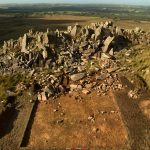Geologists and archaeologists have long known that the builders of Stonehenge made use of two main types of stone: a silcrete, known as ‘sarsen,’ was used for the large trilithons, sarsen circle and other monoliths, and a variety of ‘bluestones’ — used for the smaller standing stones — were erected in an inner ‘horseshoe’ and an outer circle. Two ancient quarries in the Preseli hills of west Wales — Carn Goedog and Craig Rhos-y-felin — have now been excavated to reveal evidence of megalith quarrying around 3000 BC — the same period as the first stage of the construction of Stonehenge.
















